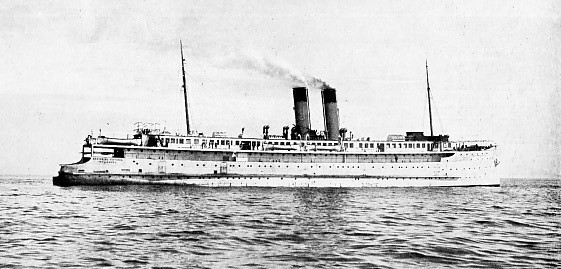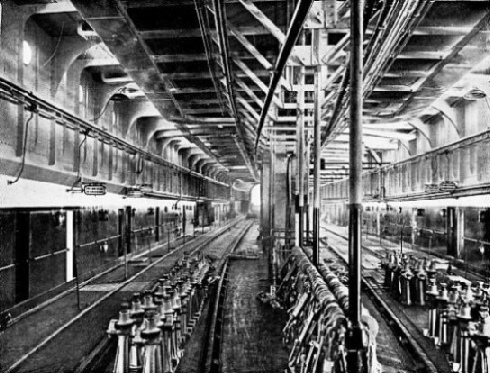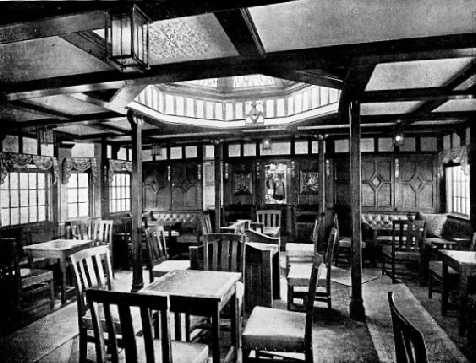

© Shipping Wonders of the World 2024 | Contents | Site Map | Contact Us | Cookie Policy

The “Drottning Victoria”
This ship plies between Sassnitz (Germany) and Trelleborg (Sweden), a sea passage of 65 miles

BROADSIDE VIEW OF THE DROTTNING VICTORIA AT SEA
This boat plies between Sassnitz (Germany) and Trelleborg (Sweden), a sea passage of 65 miles.
DESPITE the high standard to which the railway ferry has attained in the United States and Canada, one must come to Europe to see its most imposing development from the all-
This ferry service was brought into operation by the German and Swedish Governments at an outlay of nearly £1,000,000, the respective countries contributing two vessels each to the fleet. The two German boats were built in that country: one of the Swedish craft was constructed in Sweden, while the other, Drottning Victoria, was furnished by Swan, Hunter, and Wigham-
The main deck carries two sets of metals, which are sufficient to receive eight bogie passenger-
The arrangements for securing the coaches are interesting. Along the deck heavy shackles are fitted both inside and outside the track. The former are spaced 4 feet 4 inches apart, while the latter are placed at intervals of 8 feet 8 inches. Specially designed screws are attached to these deck plates and shackles provided on the coach frame, to hold the coach absolutely rigid. But, as an extra precaution during heavy weather, additional similar screws are introduced between the top of the car and the deck girders on each side, thereby protecting the superstructure of the coach from swaying motions. In order to relieve the strain upon the car springs during transit heavy jacks are placed beneath the carriages and extended just sufficiently to lift the coach-
interesting. Along the deck heavy shackles are fitted both inside and outside the track. The former are spaced 4 feet 4 inches apart, while the latter are placed at intervals of 8 feet 8 inches. Specially designed screws are attached to these deck plates and shackles provided on the coach frame, to hold the coach absolutely rigid. But, as an extra precaution during heavy weather, additional similar screws are introduced between the top of the car and the deck girders on each side, thereby protecting the superstructure of the coach from swaying motions. In order to relieve the strain upon the car springs during transit heavy jacks are placed beneath the carriages and extended just sufficiently to lift the coach-
STERN VIEW OF THE DROTTNING VICTORIA
Showing the car deck and berthing arrangements.
The ferry is equipped with magnificent accommodation for the comfort of the passengers, the appointments being carried out upon the most liberal lines, so that the craft is both a ferry and steamship in one. Indeed, an atmosphere of luxury such as is seldom approached upon cross-
As the ferries make the crossing at night, many passengers do not wish to forsake their sleeping quarters in the train, and yet desire the conveniences concerning heat and attention incidental to modern travel. The steam heating facilities of the train, therefore, are coupled to the ship’s heating system by a connection at the buffer stops, while electric-

CAR DECK OF THE DROTTNING VICTORIA LOOKING AFT
Showing screws whereby the train is secured to shackles in the floor, and jacks, which placed beneath the axles of the coach relieve the springs.
The vessel herself conforms in every respect with the latest ideas in shipbuilding. The hull is freely subdivided into watertight compartments, fitted with Stone-
In addition to the passenger and crew accommodation, facilities are also provided for housing the Customs staff, the railway officials, and the Postal department. The Customs officials perform their duties during the journey, while simultaneously the sorting of the mails progresses. It is admitted that, from the point of comfort and luxury, these railway ferries have no equal, while they represent a decided advance upon American practice so far as the shipbuilding craft is concerned. Each boat cost about £115,000, so that the outlay on the fleet was approximately half-

FIRST-
This boat is luxuriously furnished.
You can read more on “The Dover-
You can read more on “Train Ferries” in Railway Wonders of the World